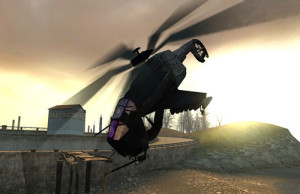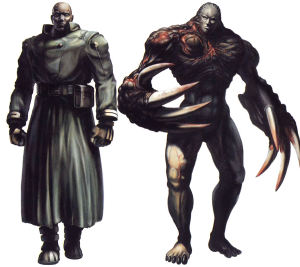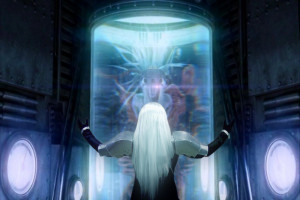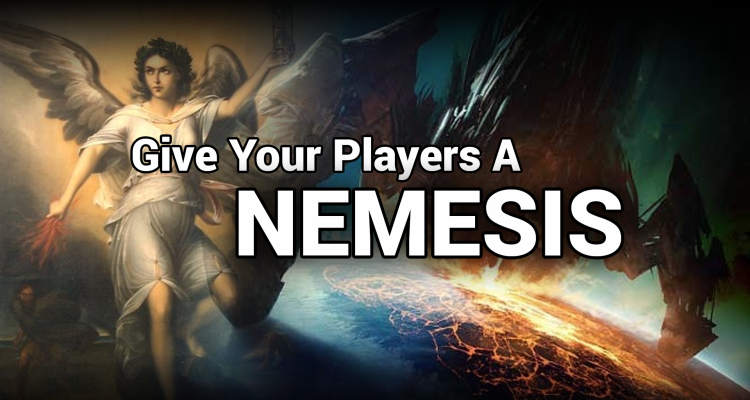A good story has conflict, and half of a conflict is a good villain. We all know the fan-favorites like Darth Vader, Voldemort, and The Joker –however, in games, villains are more difficult to handle.
Most games have an emphasis on combat -or at least on action- so it makes sense that the villain is typically reserved for the final boss battle. After all, you can’t have your villain defeated before the story has reached it’s climax. Sure, you could have your heroes narrowly escape the clutches of your villain’s first attack, but this tactic should only be used once, otherwise it makes the main enemy seem weak or incompetent.
It is necessary to find a compromise. We need an interesting and powerful enemy that will captivate players, but who will also be accessible for interactions before the final battle. This enemy must not be tied too closely to the over-arching story, since it’s destruction is highly possible. Players don’t need a villain, because villains are distant, and need to be saved for the end of the story. What players need is a foe that will harass them, break the rules of the game, chew them up, and spit them out. The players need a nemesis.
“The inescapable agent of someone or something’s downfall.”
Luckily, we don’t need to start designing the mechanics of a nemesis from scratch. We can look at a few examples of well-made enemies that fit the definition of a nemesis: “the inescapable agent of someone or something’s downfall.” Let’s check out three enemy archetypes found in many popular games. These examples have certain unique characteristics that fit the nemesis role perfectly.
The Harasser
Our first archetype uses aggressive pressure or intimidation against the players. For example, let’s look at the Hunter-Chopper from Half-Life 2. During the Water Hazard level, this combination of human and alien machinery constantly chases the player on the water and on foot. While moving on land, the chopper has complete battlefield control with it’s lethal machine gun precision. This forces the player to sprint from cover to cover between gunfire volleys, to avoid being turned to into Swiss cheese.
On the air boat, the chopper still chases the player down while unleashing it’s bursts of fire. To avoid being hit, the player must drive through tunnels at fast speeds, missing out on any secret items that might be hidden in the environment. The Hunter-Chopper also drops landmines in the player’s path, increasing it’s dominance and control over the battlefield. As a player, it is disempowering to be out gunned and out maneuvered by this strafing hunk of metal throughout nearly the entire level.
 The Hunter-Chopper’s harassment finally comes to an end when the player enters a battlefield too big for the chopper to have control over. This allows the player to observe and adapt to it’s attack patterns. Once destroyed, the weight of the machine gun fire, landmines, and distinct alien noises is lifted from the player’s shoulders. The new-found freedom to explore the level thoroughly is topped only by the satisfaction of destroying this nemesis, who has relentlessly stalked you for the past hour.
The Hunter-Chopper’s harassment finally comes to an end when the player enters a battlefield too big for the chopper to have control over. This allows the player to observe and adapt to it’s attack patterns. Once destroyed, the weight of the machine gun fire, landmines, and distinct alien noises is lifted from the player’s shoulders. The new-found freedom to explore the level thoroughly is topped only by the satisfaction of destroying this nemesis, who has relentlessly stalked you for the past hour.
“The hideout is here, a stones throw away from the apron and nestled in the old hydro plant. But getting there, with that Hunter-Chopper on your ass, next to impossible.”
City 17 Citizen
Use a harasser to slow down your players’ progress, to intimidate them with aggressive, fast-paced attacks, and to control the battlefield. The harasser should push the players to the brink of annoyance, until they turn around and punch it in the face, and finally sigh with relief. The harasser should be a short-term enemy, though, because of it’s aggressive and irritating tactics.
Examples:
- A highly mobile hunter with long-ranged weapons, heavy armor, and minions
- A hard-to hit spellcaster with area-of-effect spells, in an area of minimal cover for the players
- A stealthy agent that uses annoying poisonous effects and concealment to avoid retaliation
The Rule Breaker
It may seem obvious to include the foe from Capcom’s Resident Evil 3: Nemesis. Rewind a year to 1998, though, and you’ll see the original prototype for this character: Tyrant-00, also known as MR. X, from Resident Evil 2.
This ominous creature was slow and deliberate, in comparison to it’s sprinting and fist swinging RE3 counterpart. Mr. X’s single most terrifying feature, though, was his ability to spontaneously disrupt the player’s sense of security. Even in playthroughs of RE2’s Scenario B, this Tyrant was still able to surprise the player by spontaneously charging through walls.
 This sort of environmental manipulation wasn’t found elsewhere in the game. The only comparable enemy encounter would be with the Cerberus zombie dogs, who leapt through glass windows during a single sequence in the campaign. Breaking through windows is one thing, but hunting down a player by bursting through a wall at any given moment, is another.
This sort of environmental manipulation wasn’t found elsewhere in the game. The only comparable enemy encounter would be with the Cerberus zombie dogs, who leapt through glass windows during a single sequence in the campaign. Breaking through windows is one thing, but hunting down a player by bursting through a wall at any given moment, is another.
There are two mechanics we can take from Mr. X when designing our own nemesis. Firstly, what makes this creature compelling and frightening: it didn’t play by the same rules as the player. It had the ability to, literally, break down barriers that remained constants throughout the playthrough of Scenario A.
Until the first time it happened, the player had no reason to fear being ambushed by a hulking brute –especially not through a wall they had already passed several times. After the first time, though, the player had every reason to fear it could happen again, with any wall in the game.
“The momentum was enough for both of his huge hands to plunge into the wall across from where he’d leaned. The impact buried his fists, his arm stuck in the wood and plaster [was] halfway to his elbows.
Me… could’ve been ME–”
Claire Redfield
The second mechanic we should take note of is ROI, or return on investment. In most of the encounters with Mr. X, the player could actually bring him down with small arms’ fire. Eventually, though, Mr. X would regenerate, and return for another heart-skipping ambush. If the player managed to incapacitate the Tyrant, however, they were rewarded with more ammo than they used to bring him down. This return on investment only applied if the player had close to 100% accuracy, though.
The players had a choice: they could run away, save ammunition, and wait for the Tyrant’s next inevitable attack, or, risk wasting ammo and taking lethal punches to the face while trying to earn a decent ROI.
The key to the rule breaker is to not reveal it’s surprise rule-breaking mechanic until later in the campaign, when the players are confident with how the world works. This nemesis is perfect as a long-term enemy that the players will constantly worry about. The rule breaker should be random in it’s attacks, so that the players must remain on-edge for unexpected and intense encounters that have high-reward potential.
Examples:
- A spirit that attacks the players while they try to rest
- An elemental creature that engulfs towns and other safe areas at random
- A recurring brute with the ability to suddenly drop from the sky
The Harbinger
For our final archetype, we’ll stay in the late 90’s and take a peek at one of the most iconic RPGs in gaming history: Final Fantasy VII. This game perfectly illustrates an effective nemesis-villain dynamic, where Sephiroth is the villain, and Jenova is the player’s nemesis. Beware, spoilers are ahead..!
During FF7, the player tried to track down what they believed to be the game’s villain; Sephiroth. He was encountered fairly often, and always managed to escape. It wasn’t until a after few encounters (and dozens of hours into the story), that the truth was revealed; Sephiroth was actually shape-shifting in a cocoon the whole time. The entity that the players were interacting with was the remnant of an ancient alien life form under Sephiroth’s control, called Jenova.
“Jenova was a calamity that fell from the sky a long, long time ago; and tried to destroy the planet…”
Marlene Wallace
Jenova had four battles with the player throughout the game -each one increasingly difficult and with varying tactics. Meanwhile, the villain, Sephiroth, used his immense powers to disrupt the player’s progress remotely, and to implement his plan of becoming a god-like being. Taking all of this into account, we find that Jenova was a perpetual boss that was disguised as the villain. From a mechanical standpoint, this meant the players were distracted from the villain’s actual plan by chasing a doppelganger.
 What many people don’t realize about this nemesis-villain setup is that the iconic murder of Aerith Gainsborough was not executed by the villain Sephiroth, but rather by the nemesis Jenova!
What many people don’t realize about this nemesis-villain setup is that the iconic murder of Aerith Gainsborough was not executed by the villain Sephiroth, but rather by the nemesis Jenova!
So, was Jenova nothing more than Sephiroth’s puppet? Not quite. The conflicts in FF7 would not have existed without Jenova. She was the harbinger of a series of events that took place thousands of years before the story in FF7, so it’s only fitting that she plays a major role in the game itself. This allowed creators of FF7 the freedom to design an interesting enemy who became a nemesis, followed by a successor who ultimately plays the role of the villain.
The harbinger is ideal for long-term conflicts that have enough story to flesh out it’s vital role. It should be powerful, but elusive, in order to keep the players chasing it, and allowing the villain to implement their scheme in secret.
Examples:
- A corrupted soldier who is determined to awaken an ancient, powerful foe
- A fallen hero whose will is being controlled by the power of a brooding dark lord
- Multiple constructs that act as collectors for a well-protected, or hidden mastermind
Your villain should be perceived as powerful, and it’s time, as valuable. The villain doesn’t have the time to deal with pesky players personally –that is what their nemesis is for. Giving players a nemesis with interesting mechanical twists is a great way to engage players in a unique enemy, without sacrificing the integrity of your villain. There are many more examples of these kinds of foes in all manner of games. What are some of your favorite nemesis characters?

